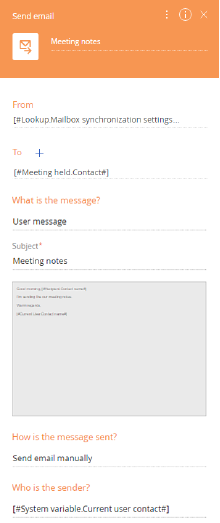The [Send Email] element is used for creating and sending new email messages automatically or manually during process execution. You can enter the email content directly when designing the process or select one of the pre-configured email templates.
Note
Be sure to set up email server integration to enable sending emails.
[Send email] element setup
Specify the email parameters on the element set up page (Fig. 9).
Fig. 9 The [Send email] element settings
Use the parameter value window and parameter value menu to fill out the element parameters.
Specify the process element purpose by typing in a header at the top right-hand side of the properties are. This will make the element more recognizable on the process diagram.
[From] – an email account integrated with bpm'online and used for sending emails. The sender is specified either dynamically or manually. If the email is sent automatically, this field is required. If the email is sent manually, this field is optional: a process user may select the email account from the available list on the email editing page.
[To] – enter the email address of a recipient (either an email address, a contact or an account). You may choose a specific account or populate the field dynamically using the parameter value window. If either a contact or an account is selected, the email address will be pulled from the [Communication options] detail. when entering a specific email address, enclose it in quotation marks, for example, "johanson@gmail.com". This is a required field.
If necessary, specify additional recipients, as well as carbon copy (cc) and/or hidden copy recipients (bcc). To do this, click the  button in the [To] area, and select the necessary fields. (CC or BCC).
button in the [To] area, and select the necessary fields. (CC or BCC).
[What is the message?] – available email types.
-
[User message] – an email created in the content designer during the element set up. It is possible to create a new email page for editing and sending emails manually during the process execution.
-
[Template message] – an email with a pre-configured template (created and configured in the content designer). The selection is made from the [Email templates] lookup.
[Subject] – enter the subject of the email. This field is required for manual send outs. If you are using templates, this field is populated automatically.
If you selected “User message”, enter the necessary message in the work area. Use the content designer to customize the message body, add images and process parameters to it (Fig. 10).
Fig. 10 Editing the email body in the content designer
Note
When you select a template, changing the email body is only possible if the message is sent manually.
[How is the message sent?] – select the send out method:
-
[Send email manually] – a new email editing page will open for the user during business process execution. Select this option if the user must view and edit the email before sending it.
-
[Send email automatically] – a pre-configured email is sent automatically during business process execution. Requires an address in the [From] field. Select this option if you need to send notifications and other automatic messages.
[Who is the sender?] - the user who is responsible for sending out this email. This is a required field. Only used for manual send outs.
[Show page automatically] – select the checkbox if you want the email page to be shown to the user when the process item is executed. If the checkbox is cleared, a draft of the email will be created during the process execution. Only used for manual send outs.
[Connected to] – specify other system records that are connected to this email. For example, to display an email message on the [Email] detail of the account page. You can fill in these fields using the parameter value window. Only used for manual send outs.
[Importance] – Select the priority of the sent message. Used to categorize outbound emails. Only used for automatic send outs.
[Ignore email errors] – select the checkbox to send email despite email-related errors. If there was an issue with sending an email, the business process will also end with an error. Used for automatic send outs only.
Next
•[Open edit page] process element
•[Auto-generated page] process item
•[Pre-configured page] process element
See also








